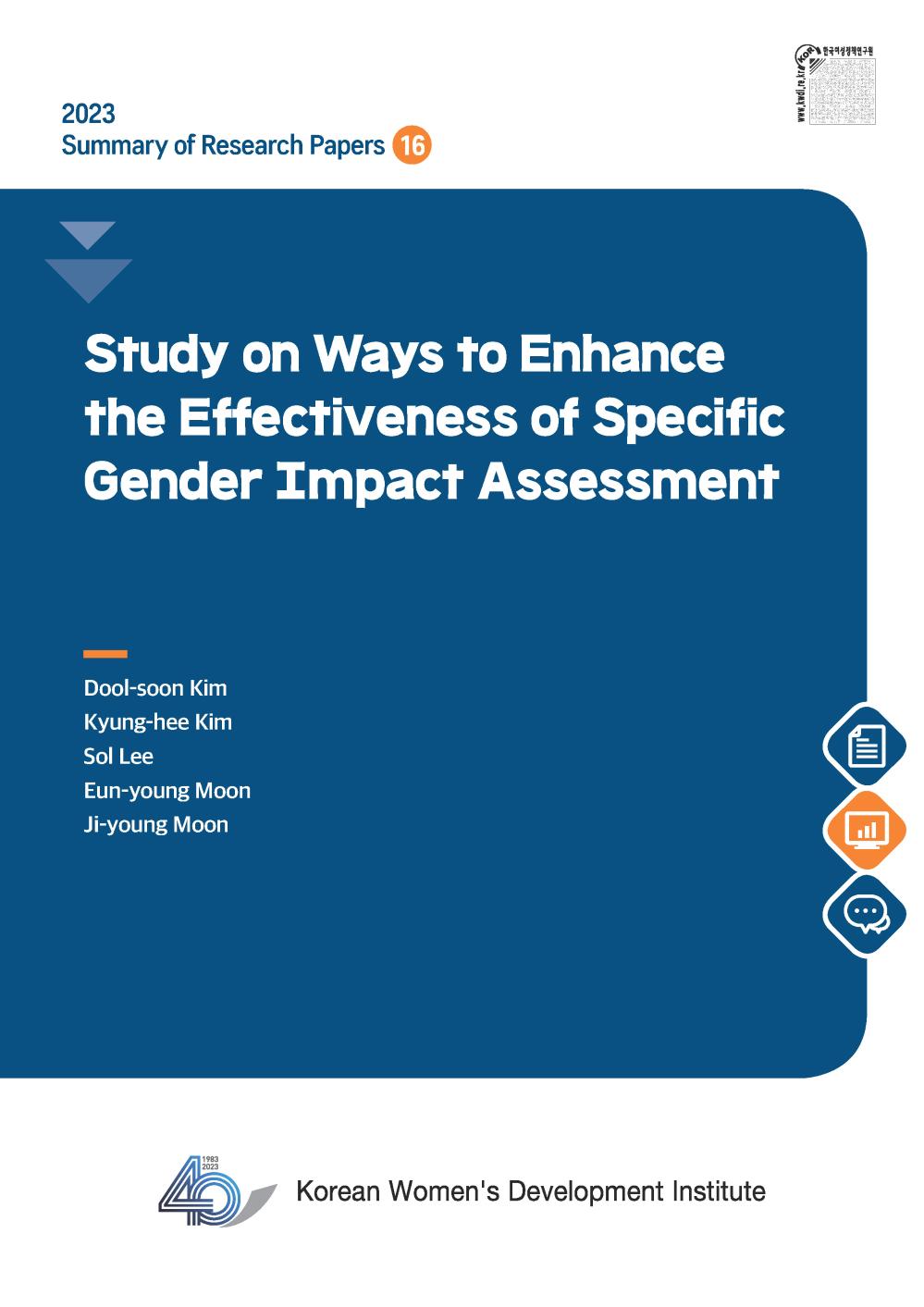Report
| Study to Enhance the Effectiveness of Specific Gender Impact Assessment | ||||||||||||||||||||||||||||||||||||||||||||||||||||||||||||
|---|---|---|---|---|---|---|---|---|---|---|---|---|---|---|---|---|---|---|---|---|---|---|---|---|---|---|---|---|---|---|---|---|---|---|---|---|---|---|---|---|---|---|---|---|---|---|---|---|---|---|---|---|---|---|---|---|---|---|---|---|
| Type | Basic | Period | 2023 | |||||||||||||||||||||||||||||||||||||||||||||||||||||||||
| Manager | Dool-Soon Kim | Date | 2023-12-29 | |||||||||||||||||||||||||||||||||||||||||||||||||||||||||
| Fiie | 16_특정성별영향평가 제도의 실효성 제고 방안 연구.pdf ( 2.08 MB ) | |||||||||||||||||||||||||||||||||||||||||||||||||||||||||||
|
Abstract Study to Enhance the Effectiveness of Specific Gender Impact Assessment Dool-Soon Kim Kyung-Hee Kim Sol Lee Eun-Young Moon Ji-Young Moon
This study analyses the policy improvement outcomes of Specific Gender Impact Assessment (henceforth SGIA) and investigates methods to make SGIA more effective in enhancing gender equality. The passing of the Act of Gender Impact Assessment in 2012 makes it necessary to evaluate how successful SGIA has been in achieving gender equality. For such a purpose, the research contents and methods used here are as follows. Firstly, research contents include an analysis of policy improvement outcomes, an examination of major actors’ experiences and policy needs, and an investigation of how the SGIA implementation system may be innovated. Secondly, the scope of this research are SGIAs undertaken by the Ministry of Gender Equality and Family(MOGEF) between 2012 and 2020. Thirdly, research methods include a review of literature on SGIA, a content analysis on research papers and related administrative documents, and interviews with twenty major actors involved in each stage of SGIA implementation. The central findings can be summarised as follows. Firstly, the UN and member states of the EU, and Canada make good use of SGIA as a policy tool for gender mainstreaming, and GIA has been closely intertwined with national gender equality goals. This means that GIA can work effectively towards the specified national gender equality goals. Secondly, amongst the research projects of SGIA undertaken by the MOGEF between 2012 and 2020, it is found that the suggestions for policy improvement have been pursued only in a few exceptional cases. This is based upon an analysis of policy improvement suggestions, contents of recommendations, and the degree of policy improvement implementation detailed in thirty research papers in the fields of social welfare, employment, industry, trade, and small-medium-sized enterprise. Thus, it is necessary to seek ways to make better use of the research results of SGIA. Thirdly, those policy improvement suggestions in the SGIA research papers that are then selected as recommended programmes by the body in charge have a higher rate of implementation. Therefore, it is important to increase the acceptance rate of policy improvement suggestions as recommended programmes. Fourthly, according to interviews, it seems necessary to create a pre-introductory workshop or consultation process in order to encourage participation of body in charge of the policy and seek their consent, either at the stage of selection of targeted programmes or at the stage of announcing recommended programmes for policy improvement. To improve the quality of SGIA research papers, it is necessary to develop and provide a research guide to help participating researchers understand clearly the features of SGIA: its purpose, research contents, how to draw policy improvements, and so on. Also, the Central Committee of Gender Impact Assessment (henceforth CCGIA) should be activate in the process of discovering and selecting targeted programmes and announcing recommended programmes for policy improvement. Fifthly, it is important that governmental bodies designate a unit fully in charge of gender equality policies, and retain gender experts as full-time staff, to ensure SGIA works smoothly at all stages of institutional implementation. Following on from these findings, further recommendations to increase the effectiveness of SGIA are as follows. Firstly, it is necessary to define and increase awareness of the primary purpose of SGIA and hence to change perceptions of outcomes. Two primary purposes of SGIA have been identified by the various research methods in this study: one is to comprehend structural gender discrimination that underlies the outcomes of targeted programmes from a gender-relations approach, the other is to find and address the specific gender issues of targeted programmes and policy agendas.
[Figure 1] Primary Purposes of SGIA
Secondly, having agreed on the primary purposes above, approaches to evaluate the outcomes of SGIA have to be shifted accordingly. So far, when outcomes of SGIA have been evaluated, quantitative measures – such as the number of recommended programmes for policy improvement, and the percentage of acceptance and implementation of improvements – tend to be emphasised more, whereas efforts to raise public awareness of gender issues or form social consent have been less recognised. Although the immediate implementation of policy improvements is a big achievement, it is equally important to increase wider social awareness of gender issues in order to tackle structural gender discrimination and set a policy agenda from a long-term perspective, which is what SGIA ought to do. These long-term and comprehensive activities should be included in the evaluation criteria of SGIA outcomes. Thirdly, in order to meet the aims of SGIA, institutional changes alone will not be sufficient. Infrastructure needs to be strengthened and environments reformed for the enhancement of SGIA effectiveness. For instance, the goal of gender equality as a keystone of state affairs across government needs to be enshrined at state level, a unit fully in charge of gender equality policies should be established in each ministry, and gender experts should be allocated as necessary. Further, there is a need to enhance gender sensitivity of civil servants responsible for policies by designating gender training as legally obligatory education.
[Figure 2] Path to enhance the effectiveness of SGIA
Fourthly, it is necessary to strengthen the implementation system of SGIA by making current five stages of SGIA more thorough. Suggestions for concrete improvements drawn by this study in each implementing stage and the responsible bodies are briefly outlined in figure 3 below.
[Figures 3] Suggestions for concrete improvements in each implementing stage of SGIA
Research areas: Gender Impact Assessment(GIA) Keywords: Specific Gender Impact Assessment, Policy Impact Assessment, policy improvement, institutional improvement |
||||||||||||||||||||||||||||||||||||||||||||||||||||||||||||


